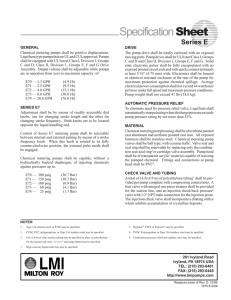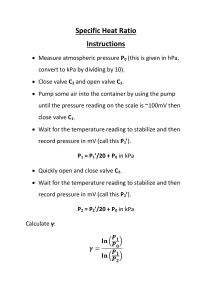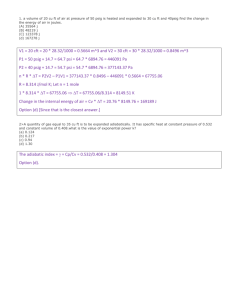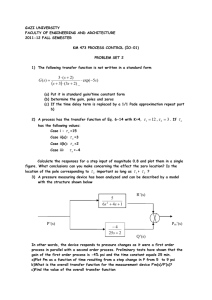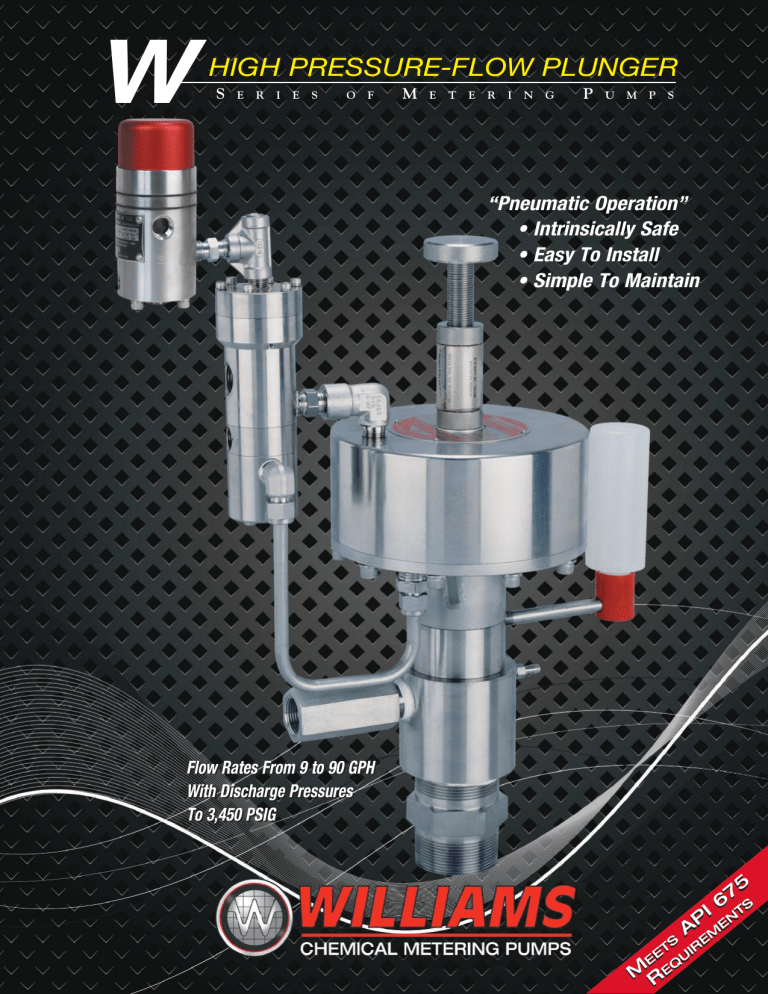
W S e HIGH PRESSURE-FLOW PLUNGER rS i e e r s i e so fo f MMe et te er ri in ng g PP u mps mps u “Pneumatic Operation” • Intrinsically Safe • Easy To Install • Simple To Maintain Flow Rates From 9 to 90 GPH With Discharge Pressures To 3,450 PSIG 5 7 I 6 ts P en A m e ts ire e e qu M e R W HI PRESSURE FLOW PLUNGER S e r i e s o f M e t e r i n g P u mps SIMPLICITY IN DESIGN, OPERATION AND MAINTENANCE STROKE LENGTH ADJUSTER FEATURES: • • • • • • • • Simple Design Easy to Maintain Intrinsic Safety of Pneumatic Operation Stroke Length and Stroke Rate Adjustment High Flow Turndown Corrosion Resistant Construction All 316 SS Wetted Parts Ease of Installation POWER STROKE AIR/GAS SUPPLY / EXHAUST PORT PNEUMATIC DRIVE CYLINDER PNEUMATIC PISTON/FLUID PLUNGER ASSEMBLY SUCTION STROKE AIR/GAS SUPPLY / EXHAUST PORT LUBRICATOR PNEUMATIC SEAL STANDARD MATERIALS: • Wetted Parts: 316 SS • Plunger: 316 SS, 17-4 SS or Ceramic • Controller - MK XIIA: 316 SS • Relays - PO4-6S or PO4-8S: 316 SS FLUID SEAL DISCHARGE CHECK VALVE LUBRICATION CHAMBER SEAL MATERIALS: • Teflon® Graphite (TG) for pressures of 1000 to 10,000 PSIG • O-Ring seals are available for pressures below 900 PSIG in various materials, K-Kalrez®, V-Viton® and BR-Buna N, EPR-Ethylene Propylene. FLUID CYLINDER SUCTION CHECK VALVE OPERATING CYCLE POWER STROKE: As the supply air/gas from the CONTROLLER-RELAY enters the PNEUMATIC DRIVE CYLINDER thru the POWER STROKE PORT, the PISTON-PLUNGER ASSEMBLY is driven down into the FLUID CYLINDER, displacing fluid. The fluid displacement results in an increase in pressure which closes the SUCTION CHECK VALVE and opens the DISCHARGE CHECK VALVE. A precise amount of fluid, corresponding to the stroke of the plunger, is discharged. SUCTION STROKE: When the air/gas is exhausted from the top portion of the PNEUMATIC DRIVE CYLINDER through the CONTROLLER-RELAY, air/gas is then supplied to the bottom portion of the PNEUMATIC DRIVE CYLINDER in order to return the PISTON-PLUNGER to its original position. The drop in pressure caused by the retraction of the PISTON-PLUNGER assembly allows the DISCHARGE CHECK VALVE to close, and the SUCTION CHECK VALVE to open. The FLUID CHAMBER is then refilled and ready for the POWER STROKE. 2 PERFORMANCE SPECIFICATIONS Max. Air Usage At Max.Volume Approx. Maximum Maximum (2) Strokes Volume 100 6.9 150 10.3 Shipping Volume Pressure Plunger Piston per per Stroke PSI Bar PSI Bar Weight Diameter Diameter Amp. Minute Stroke Length Models (Inch) (Inch) Gal./Hr. Liter/Hr. PSI Bar Ratio (SPM) (cc) (Inch) SCF/D SCM/D SCF/D SCM/D Lbs. Kg. CRP1500W400 1 1/2 4 22.90 86.40 950 66 4:1 1-40 36.0 1 1/4 8,170 231 11,732 332 33 15.0 CRP1500W600 1 1/2 6 22.90 86.40 1,800 124 13:1 1-40 36.0 1 1/4 18,384 520 26,398 455 39 17.7 CRP1500W800 1 1/2 8 22.90 86.40 3,200 221 23:1 1-40 36.0 1 1/4 32,683 925 46,931 1,328 44 20.0 CRP2250W600 2 1/4 6 90.00 336.00 1,000 69 6:1 1-35 160.0 2 1/2 32,173 911 46,197 1,308 59 26.8 CRP2250W800 2 1/4 8 90.00 336.00 1,659 114 12:1 1-35 160.0 2 1/2 57,196 1,619 82,129 2,325 84 38.2 CRP2250W1000 2 1/4 10 90.00 336.00 ? ? 12:1 1-35 160.0 2 1/2 57,196 1,619 82,129 2,325 84 38.2 NOTE: (1) The minimum volume recommended for any pump should be calculated on the basis of 1/4 inch minimum stroke length and 5 strokes per minute minimum speed with controller, or 1 stroke per minute with solenoid. (2) The maximum discharge pressure is achieved using 150 PSI (10.3 BAR) air/gas supply pressure. PLUNGER PUMP SELECTION GUIDELINES STROKE RATE AND LENGTH Even though the pumps are designed to operate over their entire stroke rate and length ranges, we suggest that you take into consideration your future flow requirements. Rather than operating at the flow extremes you may wish to use the next pump size larger or smaller. FILTRATION Plunger pumps are susceptible to contamination. Therefore, we recommend a 100 Mesh filter in the suction line of the pump. SUCTION CONDITIONS The W Series plunger pumps are designed for flooded suction only. They are NOT recommended for a suction lift condition. The recommended pressure at the suction inlet is: 1 ft. (.3 meters) min. • 10 ft. (3 meters) max. NOTE: The normal cracking pressure of the discharge check valve is 90 PSI. ACCURACY ± 0.5% with Solenoid Valve and WPC-9001 ± 1.5% with MK XIIA Controller AIR/GAS SUPPLY The air/gas supply must always be regulated since fluctuating pressures will affect speed and accuracy. The air/gas must be free from particulate and we recommend dry air/gas for trouble free operation. Since the controller and relay operate at different pressures they must have separate regulated supplies. PUMP SETTING GAUGE We recommend the use of a pump setting gauge as a simple method of adjusting the flow of the pump. DISCHARGE LINE CHECK VALVE It is good design practice to install a check valve in the pump discharge line at the point it enters the process line. This will prevent the process fluid from reaching the pump. AMPLIFICATION RATIO The amplification ratio is the area difference between the air piston and the fluid plunger. To ensure a longer operational life of the pump, it is important not to use a greater air supply pressure than is necessary to provide positive chemical injection. Assuming a specific amplification ratio, the air supply pressure must be regulated to ensure that the pump discharge pressure is greater than the process pressure. In calculating the proper air supply pressure, add 200 PSI (13.8 BAR) to the process pressure, then divide by the amplification ratio. VISCOSITY The maximum recommended viscosity is 4,500 SSU (Saybolt Seconds Universal) or 960 CP (Centipoise). FLOW TURNDOWN RATIO: 100:1 EXAMPLE: NOTE: The flow turndown ratio is defined as the total flow range of the pump, which includes both speed and stroke length adjustments. A) Assume a process pressure of 2800 PSI (193 BAR) (process pressure is the pressure into which the chemical is injected). TEMPERATURE The seal material is the limiting factor: TG (Teflon® Graphite): -30° to 180°F (-34° to 82°C) Viton®: -10° to 200°F (-23° to 93°C) Buna N: -40° to 200°F (-40° to 93°C) Kalrez®: 32° to 200°F (0° to 93°C) EPR (Ethylene Propylene): -40° to 200°F (-40° to 93°C) 3 B) Add 200 PSI to the process pressure so that the chemical is positively injected: 2800 PSI + 200 PSI = 3000 PSI (193 BAR + 13.8 BAR = 206.8 BAR). C) Assume using a Williams pump with an amplification ratio of 23:1 (implies that for every 1 PSI (1 BAR) input pressure, the pump produces 23 PSI (23 BAR) output pressure). D) Supply of air or gas pressure to controller is: 3000 ÷ 23 = 130 PSI (206.8 BAR ÷ 23 = 9 BAR). Control Methods for the Pump MK XIIA OSCILLAMATIC® CONTROLLER STROKE RATE CONTROL KNOB NEEDLE VALVE OPTIONAL 3-15 CONTROL PORT (MK XIIB) 1/8” NPT CONTROL AIR PASSAGE CONTROL SPOOL UPPER DIAPHRAGM MIDDLE DIAPHRAGM AIR/GAS SUPPLY TO CONTROLLER LOWER DIAPHRAGM SUPPLY TO PUMP 1/4” NPT SUPPLY VALVE EXHAUST FROM PUMP 1/4” NPT EXHAUST VALVE The MK XIIA Controller operates on the same operating principal as the MK X Controller. The MK XIIA has the same upper and lower chambers, but are separated with flexible diaphragms rather than sliding seals. A capillary tube, controlled by a needle valve, transfers the air/gas supply to the pump from the lower to the upper chamber. When the spool is in the highest position, a pilot plug closes a vent and opens the supply air/gas to the pump. When the spool is in its lowest position, the pilot plug prevents the supply air/gas from entering the pump, and opens the air/gas vent to let it exhaust the pump. The spool then returns to its highest position to repeat the process. CONTROLLER-PNEUMATIC RELAY COMBINATION PILOT PULSES FROM CONTROLLER EXHAUST NO. 1 PUMP POWER STROKE NO. 1 SUPPLY PRESSURE PUMP RETURN STROKE NO. 2 EXHAUST NO. 2 All models of the P1500W and P2250W use the PNEUMATIC RELAY in combination with the MK XII CONTROLLER. The PNEUMATIC RELAY is a pilot operated valve designed to provide the higher air or gas flows rates necessary to operate the larger diameter PNEUMATIC DRIVE CYLINDERS. The PNEUMATIC RELAY is actuated by the pulses produced by the MK XII Oscillamatic® controller. In the P1500W and P2250W pumps the supply air is used on both the POWER and SUCTION strokes. The PNEUMATIC RELAY is double acting. It alternately supplies and exhausts the air/gas to the top and bottom of the piston driving it up and down. CONTROLLER RELAY INSTALLATION ON PUMP DOUBLE ACTING SOLENOID VALVES WPC 9001 The pumps can be automated by replacing the CONTROLLER with a 3-way electro-pneumatic SOLENOID VALVE. The SOLENOID VALVE can be cycled in order to achieve the desired pump output. Flow tracking can be accomplished by having a FLOWMETER or PH METER signal interpreted by our WPC9001 or a PLC. The typical arrangement for a WPC-9001 installation is shown at right. WPC9001 STROKES PER MINUTE 600 115 VAC Power 230 VAC Supply PUMP RATE 12345678 TOTAL 24 VDC, 0.5 A PUMP 1 SELECT RESET NO FLOW PUMP 2 AUTO CONTROL MANUAL 4-20 mA Signal MANUAL ADJUST LOSS OF I/P 0 100 % Regulator 3 Way Solenoid Valve Air Supply @ Solenoid 35 to 100 PSI Air Supply @ Relay 35 to 150 PSI Exhaust Regulator Relay Pump Flow Meter or PH Meter Chemical out PROCESS FLUID 4 115 VAC Power 24 VDC, 0.5 A Chemical in PERFORMANCE 160 150 140 20.0 5 100 80 60 50 40 200 300 400 500 600 700 800 DISCHARGE PRESSURE - PSIG 900 5.0 2.5 20 0 200 PR 160 150 140 80 100 80 0 0 180 90 80 70 160 150 140 60 120 10 20 0 200 400 600 800 1000 1200 1400 1600 DISCHARGE PRESSURE - PSIG 0 1100 1800 MAX FLOW (GPH) 70 FLOW - GPH 60 50 40 180 160 150 140 S E PR E UR SS GA R/ AI 80 10 20 0 0 200 400 600 800 1000 1200 1400 1600 1800 2000 2200 2400 2600 2800 3000 DISCHARGE PRESSURE - PSIG CRP2250W1000 5 100 20 0 CRP2250W800 120 60 50 40 30 0 2000 200 AS 20 STROKE LENGTH: 100% ï PLUNGER SPEED: 35 SPM AIR/G 80 60 50 40 0 990 100 PSIG AIR/GAS AS 220 330 440 550 660 770 880 DISCHARGE PRESSURE - PSIG /GAS 50 PSIG AIR G R/ AI RE 100 AIR/GAS 150 PSIG 30 SU ES 100 PSIG AIR/GAS /GAS 50 PSIG AIR FLOW - GPH 80 AIR/GAS PRESSURE PSIG MAX FLOW (GPH) PR 110 PSIG 150 100 40 80 0 200 50 PR CRP2250W600 STROKE LENGTH: 100% • PLUNGER SPEED: 35 SPM 90 E AS /G AIR 100 20 CRP1500W800 100 RE U SS 10 800 1200 1600 2000 2400 2800 3200 3600 4000 DISCHARGE PRESSURE - PSIG 30 120 20 2.5 400 40 160 150 140 20 5.0 0 60 50 180 60 50 40 60 50 40 0 70 FLOW - GPH FLOW - GPH 7.5 S GA R/ AI 90 /GAS 150 PSIG AIR 10.0 0 2000 200 MAX FLOW (GPH) /GAS 50 PSIG AIR E UR S ES 180 120 AS IG AIR/G 150 PS 12.5 1800 S 100 PSIG AIR/GA 15.0 AIR/GAS 100 PSIG /GAS 50 PSIG AIR 17.5 400 600 800 1000 1200 1400 1600 DISCHARGE PRESSURE - PSIG STROKE LENGTH: 100% • PLUNGER SPEED: 35 SPM 100 200 AIR/GAS PRESSURE PSIG MAX FLOW (GP H) 20.0 80 60 50 40 0 0 1000 PR 100 CRP1500W600 STROKE LENGTH: 100% • PLUNGER SPEED: 40 SPM 22.5 E AS /G R AI CRP1500W400 25.0 RE U SS AIR/GAS PRESSURE PSIG 100 10.0 120 AIR/GAS PRESSURE PSIG 0 12.5 7.5 20 0 15.0 160 150 140 GAS IG AIR/ 150 PS PR 150 PSIG AIR/GAS S GA R/ AI E 100 PSIG AIR/GAS 10 UR S ES 17.5 FLOW - GPH 120 180 /GAS 100 PSIG AIR 22.5 200 MAX FLOW (GPH) 50 PSIG AIR/GAS 15 50 PSIG AIR/GAS FLOW - GPH 20 180 AIR/GAS PRESSURE PSIG MAX FLOW (GPH) STROKE LENGTH: 100% • PLUNGER SPEED: 40 SPM 25 200 AIR/GAS PRESSURE PSIG STROKE LENGTH: 100% • PLUNGER SPEED: 40 SPM 25 PLUNGER MATERIAL SELECTION The materials available vary in hardness and chemical compatibility. We offer three materials based on our many years of industry experience with various chemicals. Hardness is a key property when selecting the proper plunger material. Our experience has shown that the harder plunger materials not only provide longer plunger life, they also provide greater seal life. A hard plunger is a must when pumping a chemical that is prone to crystallization or if the chemical is contaminated. Of course both of the above conditions will affect seal life. Below is a table that compares the chemical compatibility and hardness properties of each material. DESIGNATION MATERIAL CR Ceramic HARDNESS CHEMICAL COMPATIBILITY Between Sapphire and Diamond on the Mohs’ Scale Excellent Chemical Inertness in all Acids, Bases, Solvents A 17-4 ph 40 Rc General Corrosion-resistant Stainless Steel Limited Acid Resistance B 316 SS 28 Rc Excellent Corrosion-resistant Stainless Steel Limited Acid Resistance We recommend the use of ceramic because of its extreme hardness and excellent chemical inertness. SEAL MATERIAL SELECTION The seal material must be chosen to satisfy both the chemical compatibility and the pressures/temperatures at which you are operating. Below is a general guideline for seal material selection. MATERIAL MATERIAL TG Teflon® Graphite SEAL SEAL TYPE TYPE TEMP TEMP RANGE RANGE Mechanical (Spring Loaded) -30 to 180°F -34 to 82°C SUGGESTED SUGGESTED PRESSURE PRESSURERANGE RANGE 1000 to 10,000 psi 70 to 690 bar COMMENTS COMMENTS Tough material with excellent wear resistance. Excellent chemical inertness. Good for all types of chemicals, acids, bases or solvents. Recommended for use with the harder ceramic plunger and higher pressures. Soft material with fair wear resistance. Broad chemical compatibility but its not to be used with ethyl or methyl alcohols. Suggested only for hard to seal fluids in low pressure applications when PE or TC will not seal. V O-ring -10 to 200°F Viton® -23 to 93°C 100 to 750 psi 6.9 to 52 bar BR O-ring Buna N -40 to 200°F -40 to 93°C 100 to 750 psi 6.9 to 52 bar Soft material with fair wear resistance. Limited chemical compatibility. Used mainly in Methanol pumping at low pressure. K O-ring 32 to 200°F Kalrez® 0 to 93°C 100 to 750 psi 6.9 to 52 bar Soft material with fair wear resistance. Excellent chemical compatibility. Used when Viton® is not compatible and PE or TC will not seal. EPR O-ring -40 to 200°F Ethylene -40 to 93°C Propylene 100 to 750 psi 6.9 to 52 bar Material has very good abrasion resistance. Excellent chemical resistance to phosphate esters, good to excellent to mild acids, alkalis, silicone oils and greases, ketones and alcohols. Not recommended for petroleum oils or di-esters. Selecting the proper seal material for your application is important. We suggest using the harder plastic seals ( TG) whenever possible because they provide excellent wear life. The elastomers (V, BR, K or EPR) offer enhanced sealing at low pressure because they are soft and more compliant than the plastics. However, the elastomers do not provide the same toughness or wear resistance. 6 PART NUMBERING SYSTEM CR P2250 W 600L B 316 TG CR- Controller - Relay Control SR - Solenoid - Relay Method Seal Material Wetted Parts AIR/GAS DRYER PRESSURE REGULATOR Plunger Options DUMP VALVE 600 - 6” Piston Diameter 800 - 8” in Hundredths of an Inch B - 316 SS 3-WAY SOLENOID VALVE 24VDC PULSE RATE SETTING GAUGE WPC9001 STROKES PER MINUTE 600 PUMP RATE 12345678 TOTAL PUMP 1 SELECT FLOW OR PH METER TYPICAL INSTALLATION RESET NO FLOW PUMP 2 AUTO CONTROL INLET FILTER MANUAL ADJUST LOSS OF I/P MANUAL CHECK VALVE WPC 9001, APU, OR PLC 0 100 % FLOWMETER PROCESS FLUID AIR/GAS DRYER PUMP & CONTROLLER AIR/GAS DRYER DUMP VALVE PUMP 3-WAY SOLENOID VALVE 24VDC PULSE CHEMICAL SUPPLY TOTALIZER DUMP VALVE AIR/GAS SUPPLY 4-20mA SIGNAL A - 17-4 SS PUMP 1000 - 10” PRESSURE REGULATOR 316 SS CR - Ceramic AIR/GAS SUPPLY 4-20mA SIGNAL BR - Buna N EPR - Ethylene Propylene Series 400 - 4” V - Viton® K - Kalrez® P1500 - 1 1/2” Plunger Diameter in P2250 - 2 1/4” Thousands of an Inch W - All 316 SS TG - Teflon® Graphite PRESSURE REGULATOR RATE SETTING GAUGE RATE SETTING GAUGE AIR/GAS SUPPLY WPC9001 STROKES PER MINUTE 600 PUMP RATE 12345678 TOTAL PUMP 1 SELECT FLOW OR PH METER RESET NO FLOW PUMP 2 AUTO CONTROL MANUAL CHECK VALVE WPC 9001, APU, OR PLC INLET FILTER MANUAL ADJUST LOSS OF I/P 0 100 % CHEMICAL SUPPLY CHECK VALVE INLET FILTER FLOWMETER PROCESS FLUID CHEMICAL SUPPLY TOTALIZER FLOWMETER (1) Note the controller would not be used with the solenoid valve. TOTALIZER PUMP & CONTROLLER FlowTracking Controller Configuration DUMP VALVE RATE SETTING GAUGE DIMENSIONS Standard Pneumatic Controller Configuration AIR/GAS DRYER PRESSURE REGULATOR AIR/GAS SUPPLY CHEMICAL SUPPLY CHECK VALVE INLET FILTER 12 7/8" (327 mm) FLOWMETER CONTROLLER PO4-6S RELAY PROCESS FLUID PROCESS FLUID 19 1/2" (495 mm) CONTROLLER TOTALIZER PO4-8S RELAY (CRP2250W800L ONLY) PO4-6S ALL OTHER MODELS 19 1/2" (495 mm) DISCHARGE CHECK VALVE 3/4" NPT (F) DISCHARGE CHECK VALVE 3/4" NPT (F) 22 1/2" (572 mm) SUCTION CHECK VALVE 2" NPT (M) SUCTION CHECK VALVE 2" NPT (M) CRP2250W CRP1500W 7 PUMP ACCESSORIES DRUM GAUGES (2) Liquid Level/Injection Rate Gauge MODELS MATERIALS C779WS Carbon Steel C779WS-V Carbon Steel - Vented C779WS/SS Stainless Steel C779WS/SS-V Stainless Steel - Vented 30216-CS-V-GPD-S Carbon Steel 30216-S6-V-GPD-S Stainless Steel LIQUID CHEMICAL FILTERS (1) 316 Stainless Steel MODELS CONNECTION FILTER ELEMENT OPTIONAL FILTER ELEMENT LCF10-25 1/4” NPT 25 micron, Std LCF15-25 1/2” NPT 25 micron, Std 1, 2, 8 microns or 100 mesh stainless steel screen WPC9001 Electronic Pump Controller NEMA MAX. OPERATING MODEL CLASS TEMP. MODES Auto WPC9001-GP 4X 140° 60° Manual F C WPC9001-XP 7Switching AUTOMATIC DUMP VALVES Used with the Air or Gas Dryer-Filters MODELS BOWL MAX. PRESSURE ADV-150-A Plastic 150 PSI ADV-250-A Steel 250 PSI PCV125 AL Pressure Regulator SENSITIVITY FLOW RATES MAX. PRESSURE 0.1 PSI 20SCFM 250 PSI 0.689kPa .566m3/min 1724 kPa AIR OR GAS DRYER-FILTERS Complete with Manual Drain Valve MODELS FLOW RATES MAX. PRESSURE J150K 40SCFM 150 PSI J500K 40SCFM 500 PSI APU-XP Automatic Processing Unit FREQUENCY ACCURACY 0-45 SPM + 0.25% of span 201 Ivyland Road • Ivyland, PA 18974-0577 • TEL: (800) 235-3421 • (215) 293-0415 • FAX: (215) 293-0498 • E-mail: info@williamspumps.com www.williamspumps.com W BROCHURE • Revised 3-2012 • Doc# IR-30951 Rev 2019
